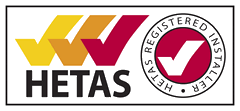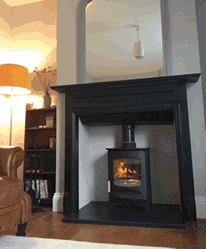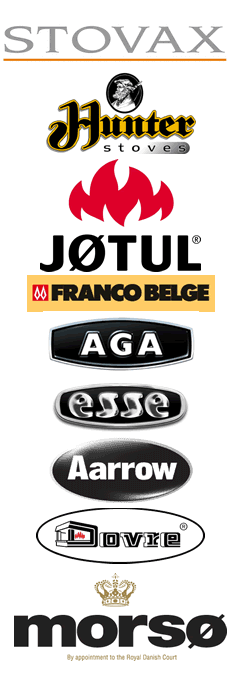Flue Liners
Frequently asked questions
What type of chimney or flue have I got?
I don't have a chimney, can I still have a stove?
Do I need to have my existing chimney lined?
What size of chimney or flue do I need for burning solid fuel?
Will I need to get my chimney swept?
Will my chimney or flue require anything to be put on the top?
Our chimney has been removed downstairs but is still upstairs and in the loft. Can I restore the fireplace downstairs?
Does my fire need ventilation?
Why do some fires require an external air vent and others don’t?
What type of chimney or flue have I got?
The type of chimney or flue can sometimes be identified by the age of the property although it is always worth arranging for a survey to be absolutely sure. Homes built before the late 1990’s will often have an open brick chimney. Homes built after that time may have a Class 1 or Class 2 chimney depending on the house specification, you need to be certain which type you have before choosing a new fire. Contact us for a survey.
I don't have a chimney, can I still have a stove?
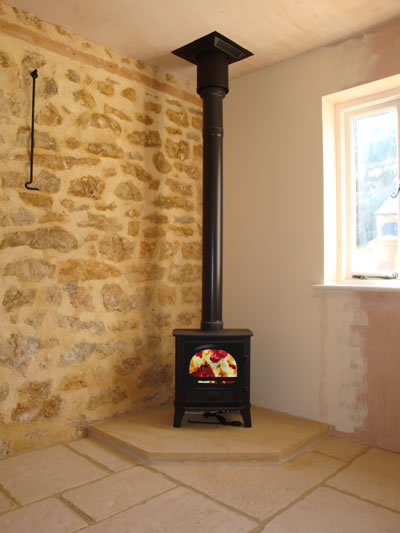 Yes, by using twin walled insulated flues it is possible to install a stove in almost any property. The flue can either go directly through an outside wall and up the wall to the required height or, as shown in the image on the right, can go up through the ceiling, if you have a bungalow the flue will go through the roof space through the roof; if you have a second or third floor the flue can pass through these until it goes through the roof. We can advise you are what is possible, call us to arrange a survey.
Yes, by using twin walled insulated flues it is possible to install a stove in almost any property. The flue can either go directly through an outside wall and up the wall to the required height or, as shown in the image on the right, can go up through the ceiling, if you have a bungalow the flue will go through the roof space through the roof; if you have a second or third floor the flue can pass through these until it goes through the roof. We can advise you are what is possible, call us to arrange a survey.
Do I need to have my existing chimney lined?
This entirely depends on the condition of your chimney. We will be able to give you further advice. It is unwise to assume that a chimney or flue works correctly simply because it is there. Testing may discover problems that are completely hidden from view like internal damage or blockage. If an existing chimney has to be lined remember that this may influence or restrict your choice of fire.
What size of chimney or flue do I need for burning solid fuel?
Burning coal, coke or wood in an open fireplace requires a chimney or flue with a minimum internal diameter of 200mm (8 inches) and constructed of a material specifically suitable for solid fuel.
For burning coal, coke or wood in a stove, the size of the chimney or flue required will be dependant on the stove choice.
Call us and we will be able to advise you further.
Will I need to get my chimney swept?
Yes. It’s always advisable to get an existing chimney or flue swept or checked before the installation of a new fire or fireplace. Contact Us to arrange for one of our engineers to come and sweep your chimney.
Will my chimney or flue require anything to be put on the top?
Cowls are used to terminate the chimney and it depends on the design and material of your chimney. A straight vertical brick lined chimney (if you look up you can see daylight) or a chimney lined with a flexible flue liner or other non porous material we would highly recommend a rain cap at minimum. Chimneys with a 'kink' in and made of brick or 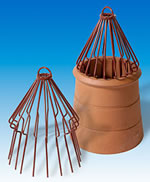 pumice/clay type liners will probably not require a rain cap as the material will soak in the
pumice/clay type liners will probably not require a rain cap as the material will soak in the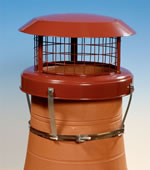 rain; However we would recommend that EVERY chimney has, at minimum, a bird guard style cowl (right), these are designed to stop birds, especially Jackdaws using your warm and dry chimney as a nesting spot. It is important that you get the right cowl for the appliance, if an incorrect cowl is fitted your chimney may not work efficiently or at all. See here for an example of an incorrectly fitted cowl for the chimney.
rain; However we would recommend that EVERY chimney has, at minimum, a bird guard style cowl (right), these are designed to stop birds, especially Jackdaws using your warm and dry chimney as a nesting spot. It is important that you get the right cowl for the appliance, if an incorrect cowl is fitted your chimney may not work efficiently or at all. See here for an example of an incorrectly fitted cowl for the chimney.
Our chimney has been removed downstairs but is still upstairs and in the loft. Can I restore the fireplace downstairs?
It is possible to replace or rebuild the chimney breast downstairs but great care must be taken to establish how the original removal of the chimney breast was carried out and completed. A chimney breast that rises through a house is often a structural component and its full or partial removal may have required new components to be added that could affect its rebuilding. Such restoration may require Building Control approval from your local authority and their advice should be sought before undertaking such work.
Alternatively a twin walled insulated flue may be used to connect up to the existing chimney upstairs; this would still require investigation but, due to the reduction of labour costs to rebuild the chimney, it would be a more economical way to proceed. You could also install a new chimney completely using twin walled insulated components. We will be able to provide you with the best option for your property.
Does my fire need ventilation?
Apart from electric fires, all open fires, irrespective of their fuel type, need an adequate supply of air to burn properly. Restricting the air for combustion may cause the fire to burn incorrectly and increase the risk of it producing toxic combustion products. It may also reduce the effectiveness of the flue or chimney.
In some cases, the ventilation can be from the room itself and does not require an air vent through an outside wall.
Why do some fires require an external air vent and others don’t?
Quite simply it depends of the type of fire you want to have installed. Fires that consume the least amount of fuel may be able to draw sufficient air from the surrounding space to work perfectly. The surrounding space is itself ventilated around the tiny, almost invisible, gaps around doors and windows and this existing ventilation may be enough for some fire types.
However existing ventilation is not always adequate for all fire types, typically any solid fuel appliance over 5KW would require an open vent of some size.

